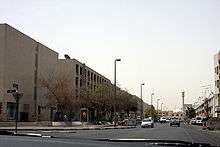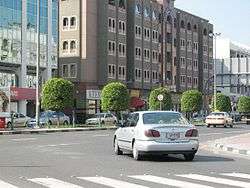Al Karama, Dubai
| Al Karama الكرامة | |
|---|---|
| United Arab Emirates community | |
|
A street in Al Karama | |
| Country | United Arab Emirates |
| Emirate | Dubai |
| City | Dubai |
| Area | |
| • Total | 1 km2 (0.4 sq mi) |
| Population (2000) | |
| • Total | 45,674 |
| • Density | 46,000/km2 (120,000/sq mi) |
| Community number | 318 |
| Coordinates | 25°14′31″N 55°18′04″E / 25.24182°N 55.30106°ECoordinates: 25°14′31″N 55°18′04″E / 25.24182°N 55.30106°E |
Al Karama, or simply Karama (Arabic: الكرامة, literally meaning dignity), is a residential district of Dubai close to Dubai Creek and part of the older area of the city. It is outwardly distinctive due to the regularity of its low-rise residential buildings. The area, which was planned on a tight grid system, is home to thousands of people even though it is only two square kilometers in size. Al Karama is the most populous residential area in Dubai,[1] outside of areas zoned to house labour accommodations. Al karama holds the privilege of district having second most number of restaurants after Deira.
Boundaries and Landmarks
It stretches for 2 km between the creekside diplomatic area to the north, containing numerous consulates, and Zabeel Park to the south, a $50-million technology-themed public park opened in December 2005. Zabeel Park divides Karama from the landmark Dubai World Trade Centre, as well as Sheikh Zayed Road and its famous skyscrapers.

The district's western boundary is Trade Centre Road, where the popular BurJuman shopping mall is located.
Inhabitants and Amenities
The majority of Karama's population has traditionally been middle class South Asian expatriates, although Dubai's cosmopolitan nature is also well represented, with the presence of many other nationalities such as people from Iran and Lebanon and many European nations. Virtually all residents are non-UAE nationals, meaning that they are obliged to rent their apartments. The typical annual rent for a one-bedroom flat was about 42,000 dirhams (US$11,500) in June 2006, having risen sharply in the previous 18 months.
Al Karama is also served by a metro station which is located in the middle of the Shaikh Khalifa Bin Zayed Street, next to the Union Co-operative supermarket. It is an elevated station with access on both sides of the road and air-conditioned pedestrian bridges.
The center of Karama is Karama Centre which is a residential building located right near the mosque. Karama is the home of Karama park (locally called Lulu park named by the children after the Lulu supermarket across the park). Many children and adults of all ages come here for leisurely activities.
One notable national community is the Omani contingent, who originally settled in Karama in the early 1980s with the help of Dubai's first modern ruler, Sheikh Rashid bin Saeed Al Maktoum, the late father of the current rulers. About 8,000 Omanis who were among the tens of thousands displaced from Zanzibar in the 1960s later found themselves stateless and homeless until Sheikh Rashid offered them sanctuary with the construction of Hamdan Colony, a collection of apartment blocks which still stand in Karama.
Growth
The area has become increasingly popular for families since self-contained apartments are slightly cheaper and offer better amenities than other parts of Dubai south of the creek. Numerous commercial units exist along the main thoroughfares. Parking space is becoming increasingly difficult to find as car parks are built over and car ownership increases. The covered parking included as a feature of many new buildings has not eased the situation.
Besides the widespread sale of counterfeit goods, reported crime is relatively high in common with other parts of Dubai south of the creek.
References
- ↑ Existing Population and Future Holding Capalities in Dubai Area. Dubai Healthcare City. 2000

